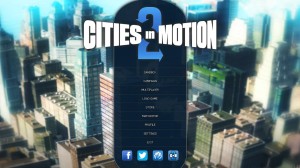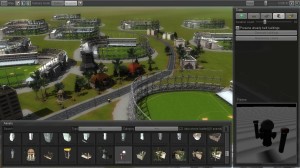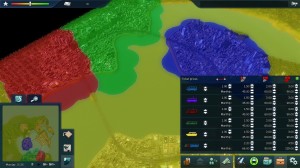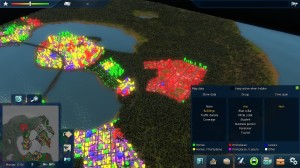Most, if not all of us, hate traffic. Needless to say, when “Cities in Motion” came out in 2011, I was all for showing…well, someone…how to handle traffic patterns and mass transit once and for all. Unfortunately, I didn’t get the chance to take screenshots of my “successes” and email them to my local city representative. Perhaps it had something to so with the fact that I failed in my attempts miserably. I enjoyed my time with “Cities in Motion”, but the difficulty curve was too darned high for my liking. A capacity mod to double the size of the busses and etc. made the game a hundred percent better in my opinion, but it was clear to me that some improvements could have been made to make the game a bit more user-friendly for the casual folks. For those of you new to the series, “Cities in Motion” tasks the player with creating a transportation network successfully around a pre-built city. It’s important to stress that “Cities in Motion” is not a full-blown city-builder like “SimCity”. Today, we’re going to take a look at “Cities in Motion 2” and determine whether or not it does things better than it predecessor. Before the citizens of this game revolt and vote me out of office (again), I’d like to thank Veronica Gunlycke from Paradox Interactive for providing me with a free review copy.
The main menu allows the player to experience the campaign, participate in sandbox and multiplayer modes, visit the in-game store, create cities in the map editor, manage profiles, and adjust game options. Creating a new profile lets you assign a name, color scheme, and a logo which is then used in both single and multiplayer games. The settings menu covers your basics like screen resolution, graphics quality, audio sliders, and etc. The online store is similar to that of “A Game of Dwarves” in that you’ll be able to purchase and download additional content as it becomes available. The map editor is also a welcome feature, giving players the ability to create their own cities. You can adjust terrain, build roads & structures, and set different variables (how many citizens own cars, etc.) to help give your city life and its own personality. I appreciate that you can place as many buildings as you want and then autofill the rest with the “generate buildings” option…it’s a time saver.
The three primary game modes (campaign, multiplayer, and sandbox) play very similarly, but each offer unique perks to the player in question to satisfy their current mood. The campaign features a tutorial and is more scripted, providing the player with a natural feeling of progression. You’ll be given a primary task with optional side missions to do for the sake of earning money and reputation. The tutorial can be accessed at any time in the options menu, should you need a refresher. Multiplayer allows up to six people to play, both cooperatively and competitively. In the case of the latter, players are allowed to go at it in a free-for-all fashion or divide up into teams, much like in real-time strategy games. The sandbox mode is a great addition, as you’ll be able to choose a map and play for as long as you want without worrying about meeting deadlines. You’ll have the option to play with unlimited funds, enable optional tasks, and disable city growth, giving you full control over your sandbox experience. All three modes have three difficulty levels to choose from: arcade, normal, and expert. I personally like the arcade mode, which is geared more towards people who like a casual experience. Though, I’m glad to see that I can bump up the difficulty if I’m feeling gutsy.
I found the interface to be streamlined a bit better in comparison to the original game. In “Cities in Motion”, I often got lost in menus and statistics…I’m pleased to report that this didn’t happen here. Your reputation bar works pretty much the same way as it did in the previous game in that it tells you how likely citizens are going to use your services. Obviously, you’ll want to keep this bar high and in the green by keeping your mass transit vehicles in good shape, your employees happy, and the citizens moving. The bottom right hand corner of the screen is your build menu, allowing you to expand your network with relative ease. I really like how the game allows you to see each line you’ve created by transit type, all at the same time. This snapshot view allowed me to quickly see what I had as a whole and edit those I thought needed tweaking. The minimap in the lower left was easy to read and allowed me to see various routes to help with my planning. You can also increase game speed or pause it, depending on your needs.
In terms of infrastructure, you’ll be able to build busses, trolleys, metro, water busses, and trams. Like in the previous “Cities in Motion” game, you’ll build depots around the city and add vehicles to the routes you specify. The ability to build roads is available, allowing you to connect different parts of your city in new ways. Like in “SimCity”, you’ll have access to avenues that allow trams to be built in between them. Unlike “SimCity”, you can build bridges and underground passages with the press of a button. One-way streets are a nice touch, allowing you to assist or restrict traffic as needed. One thing that really caught my eye was the ability to bulldoze existing city structures. While destroying city structures costs money and hurts your reputation, it might open up new possibilities for your transportation network. Different areas of the city can be assigned “zones”, giving players the ability to set ticket prices for different parts of the city. Upgrading existing stops and stations is also possible, allowing you to give varying degrees of quality to different parts of your city. While some of these features are present in the original game, the new ones, when coupled with the existing ones, add a new level of strategic depth.
A day and night cycle adds an interesting twist to the game. Citizens will travel en masse at different times, much like in real life. You’ll have the option to edit timetables appropriately to account for the morning and evening rushes. You can also adjust how many vehicles go along a particular route and how frequently they do so. With that in mind, varying social groups will actually prefer to use one particular type of service over another. For example, business people are more concerned with getting to where they are going quickly as opposed to worrying about the ticket price. Students and blue-collar workers, on the other hand, try to take cost-effective methods of transportation whenever possible. The data maps are vital in determining who lives where and what buildings citizens primarily visit. Tourists live in hotels and aren’t concerned with price as much, so plopping more expensive transit systems next to said buildings might be something to look into. I was also impressed by the fact that cities are dynamic, meaning that they change based on the decisions that the player makes. Doing well will encourage the city to grow on it own, though this means that you’ll need to constantly pay attention to how the city is unfolding and adjust your transit systems accordingly.
“Cities in Motion 2” is definitely a vast improvement over its predecessor, adding new features and gameplay elements that will keep players busy for quite some time. While there is still a considerable learning curve, the different modes allow players to experience and learn the game at their own pace. The interface is much sleeker and more user-friendly, which will further assist newcomers and help them not to be so overwhelmed on their first playthru. With all of that said, the tutorial could stand to be improved upon as it doesn’t cover everything a new player would need to know. It may behoove new players to jump into the sandbox mode with unlimited funds enabled before playing the campaign, just to mess around and see how things work. The new gameplay options and mechanics gave me a sense of freedom that I didn’t have in the original “Cities of Motion” game. I also didn’t feel as limited and helpless when things went wrong. The realism and detail of the city itself drew me in from time to time, distracting me (in a good way) from my important managerial duties. It was fun to watch the citizens go about their daily lives and react to the changes I was making around them. The map editor gives players almost unlimited replayability and truly adds to the “sandbox” experience. To sum it up, “Cities in Motion 2” is an excellent example of a sequel done right. Its current sale price of $19.99 (as of 4/2/13) is more than reasonable for the amount of content the game offers. Fans of the genre, especially those who enjoyed “Cities in Motion” but craved more, would do well to give this game a go.
Final Verdict: 9/10
—
You can learn more about and purchase “Cities in Motion 2” by visiting the following websites:
http://www.citiesinmotion2.com/
http://store.steampowered.com/app/225420/
http://www.paradoxplaza.com/games/cities-in-motion-2
You can check out gameplay videos here:
http://www.youtube.com/watch?v=nzIGMTZ3yrI
http://www.youtube.com/watch?v=-Jt2grahVb8
—






